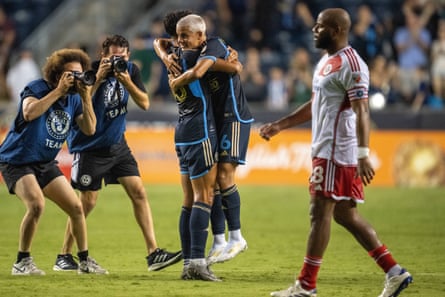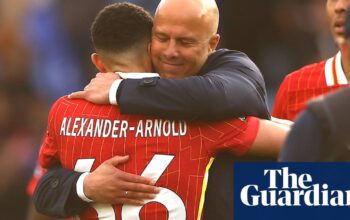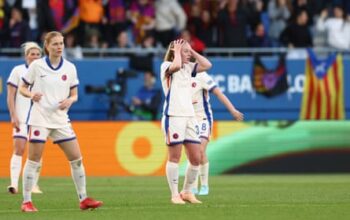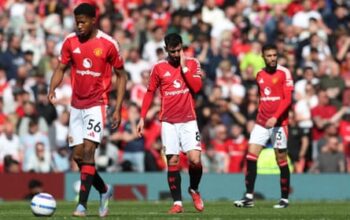The most newsworthy debut of the year in US men’s soccer lasted just eight minutes on a midsummer Wednesday evening in Chester, Pennsylvania. The debutant’s actions consisted largely of pressing the opposition, one loose touch, and an easily saved shot from distance as the game’s last action. He also completed some tidy passes, made intelligent runs, and withstood a physical challenge from an MLS veteran that knocked him to the turf.
As debuts go, it’s a blip on the radar. As debuts for 14-year-olds go, though, it was extraordinary.
Cavan Sullivan’s cameo at the tail end of the Union’s 5-1 win over New England made him the youngest-ever athlete in the history of North American team sports. It’s a milestone that has kickstarted some age-old conversations: about how young is too young for an athlete to be put in that position, and whether the world of American soccer is really equipped to handle a young player given so much attention so early on.
It speaks highly of Sullivan’s professional prospects that his ability on the field isn’t even remotely in question. He has been a regular on US youth teams, playing with the U-15 squad in 2023 when he was just 13 years old, and winning the Golden Ball award at the Concacaf U-15 championship later that year. Coaches were near-unanimous in their praise. Union head coach Jim Curtin predicted he would be a household name. Big clubs were circling, with Manchester City among the clubs expressing interest in bringing the youngster over to continue his footballing education.
In May, he signed a unique deal that made him the youngest first-team professional in the history of the Union, a team renowned for its academy system. Sullivan now owns the most lucrative homegrown contract in MLS history, and one with a clause that stipulates he will move to Man City when he turns 18 (and potentially beforehand).
Shortly after signing, Sullivan started making appearances for Philadelphia Union II, the club’s reserve team that plays in the third-tier MLS Next Pro. He compiled 10 appearances in the developmental circuit, notching an assist on his first appearance, another a a few games later, and then two goals in as many games just before his elevation to the first team this week.
And then, on Wednesday, came the most-celebrated and closely watched final eight minutes of a blowout ever.
“This is just the start,” Sullivan said afterward. “[I’m] really happy to have done this, but it’s just the first box checked off. It’s all about where you finish, not where you start.”
Sullivan’s path is his own, and there’s no telling where it might lead. Yet it’s near-impossible to consider it today without thinking of the person whose record he broke: Freddy Adu, who debuted almost exactly 20 years ago as a 14-year-old with DC United.
The state of the league could scarcely have been more different. MLS had 10 teams in 2004, and now has three times that amount. The homegrown player rule, which is now used with regularity by MLS teams to sign academy products, was still four years away from being introduced; the SuperDraft was still the league’s primary way of signing domestic players, so MLS had to engineer a trade of the No 1 overall pick that year from Dallas to DC, Adu’s hometown club. Once Adu joined DC, the first team was the only option for playing time – the club’s academy and MLS’s first attempt at a reserve league was still a year away from reality (Today, all MLS clubs have their own academies and a re-launched reserve league under the MLS Next Pro moniker has become an increasingly popular intermediate step from the youth teams to the main event.)
On Adu’s debut, the average MLS salary was just over $80,000 per year (about $134,000 in 2024 dollars). That average is now over $500,000. Adu signed with DC when David Beckham was in his first year at Real Madrid, still three years away from transforming MLS for good. Sullivan is literally in the same league as Lionel Messi, who is transforming it again.

By any measure, today’s is a healthier league for a young player to be joining. Expectations are healthily lower as a result, but it’s difficult to imagine them moving in any other direction. In 2004, Adu wasn’t just the proof MLS needed that it could be a home for promising young players – he was also the league’s most visible star. He shot a commercial with Pelé and was handed the richest contract in the league, with a guaranteed compensation of $500,000 (about $850,000 in 2024). Over 400 journalists turned out to RFK Stadium to watch his debut. He was profiled on 60 Minutes and name-dropped by Jay Z. Nike signed him to a $1m deal.
Sullivan has given his fair share of interviews and press conferences, but he’s practically a hermit by comparison. The Union youngster’s main job, at this point, is to continue to be really, really good at soccer for his age – and to get better. The pressure on him to “save” MLS, let alone American soccer, is practically zero.
after newsletter promotion
He will face physical challenges – not just in whatever game time he gets, but on an everyday basis, training alongside grown men, many of whom have been doing this professionally for a long time. The Union roster’s’s elder statesman, Alejandro Bedoya, made his professional debut six months before Sullivan had even been born.
“It was pretty cool to see the change in size from U-17 to MLS Next Pro and now the big deal,” Sullivan told the media afterward, sounding fully aware of the trials ahead. “The game’s just gonna get more and more hard for me.”
He knows the mental challenges to come – the types of things all sorts of people in all sorts of careers face in a reality where progress isn’t linear. And while he isn’t hawking Sierra Mist on commercial breaks like Adu, Sullivan will need to navigate that amid increased media attention at nearly every game. The league doesn’t need Sullivan to excel but it would be a nice feather in its cap as it seeks to prove it can be a place for very young US players to develop and get opportunities after the likes of Weston McKennie and Christian Pulisic (among others) chose to move abroad in search of those things.
Maintaining a level head while all that is going on would be hard for adults, let alone someone who is barely a teenager, who said he was surprised at the furor created by the fans as he broke Adu’s record.
“Every time I touched the ball they went crazy,” he said. “Obviously I dreamed of this day and I had some pictures in my mind of what it would look like but to have them behind my back every time the ball was at my foot was crazy to me.”
Again, Sullivan is about as well placed as he can possibly be given those expectations. His brother Quinn, six years his senior, also plays for the Union, having scored a fantastic goal just before Cavan’s introduction on Wednesday. Their grandfather, Larry, coached Curtin at Villanova University. Their father, Brendan, is a former pro. Their mother played Division I for the University of Pennsylvania, along with Brendan. As far as support systems go, it’s about as solid as one could ever hope for.
In the days since Sullivan’s debut, it’s been practically de rigeur to cite the classic sports cliche attributed to legendary Manchester United manager Sir Matt Busby: “If you’re good enough, you’re old enough.” This has almost entirely been wielded as an explanation for why Sullivan is playing, when it could instead be seen as a theory that will be tested.
Is Cavan Sullivan good enough? We don’t know for sure yet, and we likely won’t until he’s old enough to answer it confidently himself. All we know is that the environment around him is better than it was for those who came before.
Source: theguardian.com


